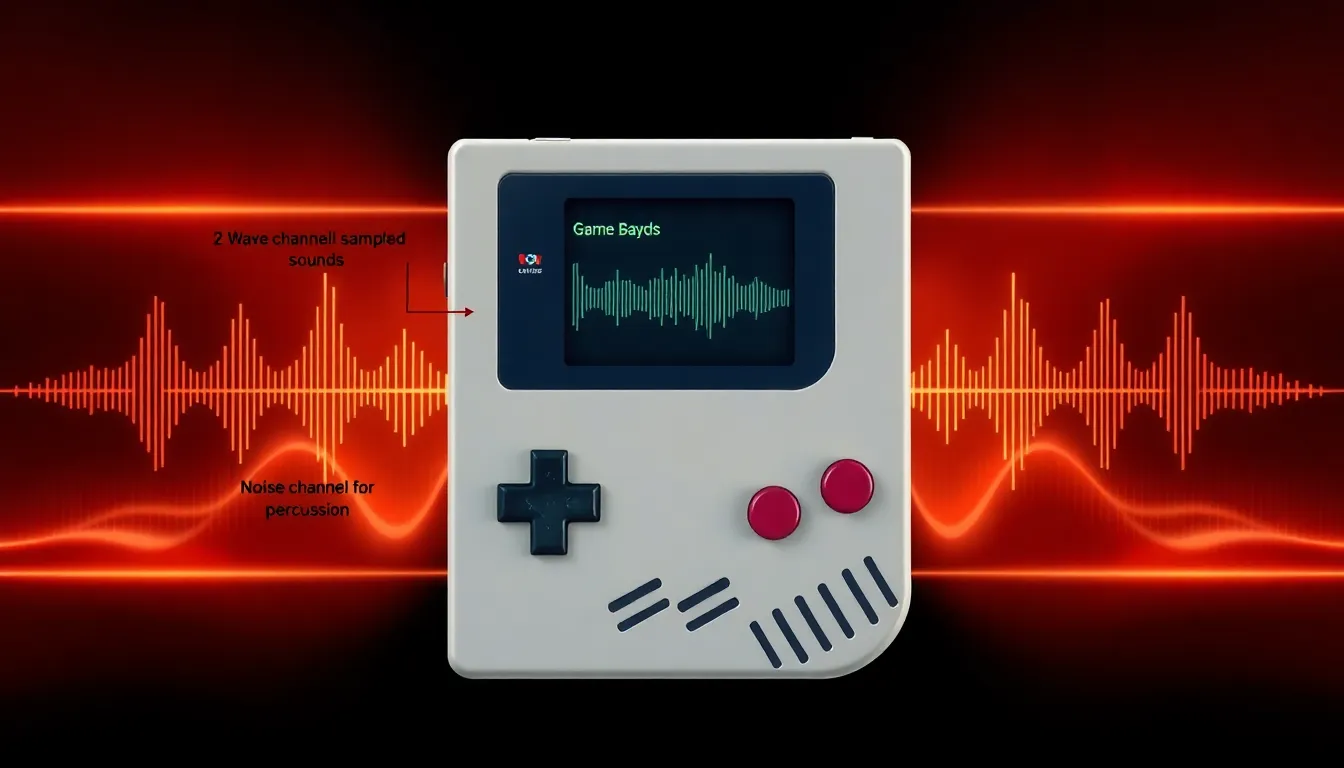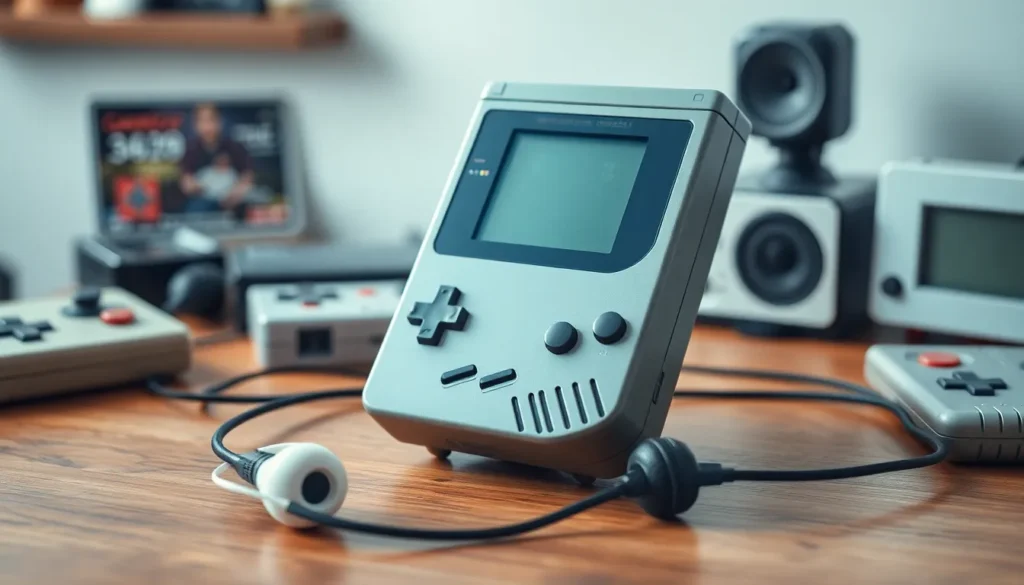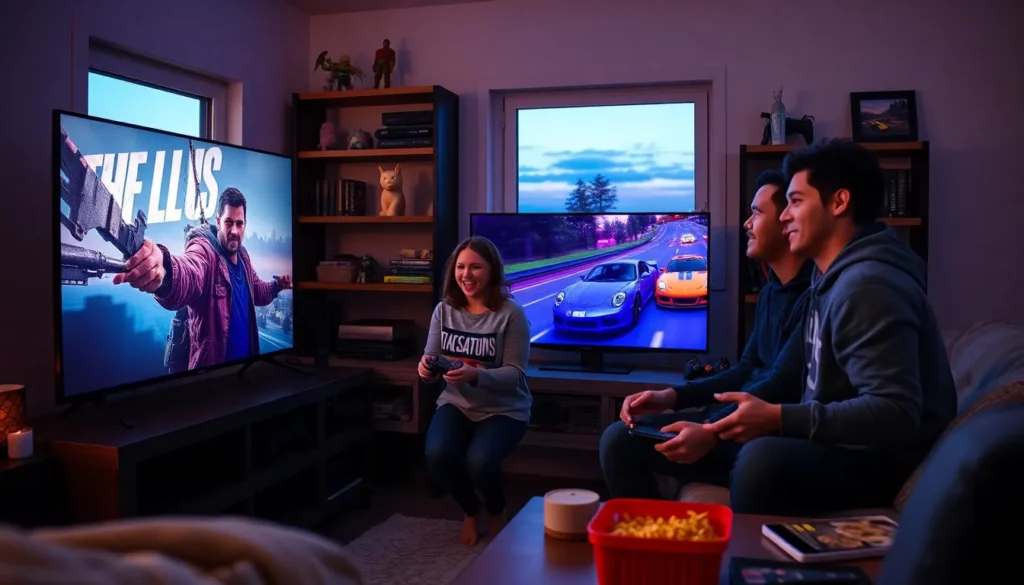Table of Contents
ToggleIn a world where high-definition graphics reign supreme, the Game Boy sound chip stands as a nostalgic beacon for gamers everywhere. This unassuming little piece of technology packed a punch, delivering unforgettable melodies and sound effects that defined an entire generation of handheld gaming. From the catchy tunes of Pokémon to the epic soundscapes of The Legend of Zelda, it transformed pixelated adventures into auditory masterpieces.
But let’s be real: it wasn’t just about the nostalgia. The Game Boy sound chip was a clever concoction of innovation and creativity. It proved that you don’t need a full orchestra to create a symphony; sometimes, all you need is a few square waves and a dash of creativity. So, let’s dive into the quirky world of this iconic chip and explore how it shaped the sound of gaming as we know it today.
Overview of Game Boy Sound Chip
The Game Boy sound chip, known as the APU, plays a critical role in the device’s audio capabilities. Designed by Nintendo, it supports four audio channels, enabling musicians to create rich and varied soundscapes. Pulse wave channels produce melodies while the wave channel supports sampled sounds, adding unique texture to gameplay.
Game Boy’s sound architecture includes two pulse wave channels (Channel 1 and Channel 2), a wave channel (Channel 3), and a noise channel (Channel 4). Channels 1 and 2 each generate sounds from square waves, allowing for adjustable frequency and volume controls. Channel 3, on the other hand, utilizes 4-bit samples, making it suitable for more complex audio. Channel 4 introduces white noise, perfect for percussion effects.
The sound chip’s architecture enabled iconic tunes in games like Pokémon and Super Mario Land. Many developers appreciated the sound chip’s capabilities, using it to create catchy soundtracks that enhanced gameplay experiences. This chip sparked creativity in composers, motivating them to explore technological limitations in their music compositions.
Nostalgia resides in the melodies produced by the Game Boy sound chip. Fans often reminisce about the unforgettable music associated with their favorite titles. The limited audio channels inspired innovation, encouraging composers to craft memorable themes with simple yet effective melodies.
The Game Boy sound chip significantly influenced handheld gaming’s auditory landscape. Its unique design enabled rich sound experiences while fostering artistic creativity in an era of technological constraints.
Technical Specifications

The Game Boy sound chip, or APU, features distinct specifications that shaped its acoustic contributions. Audio channels and frequency ranges play crucial roles in its functionality.
Sound Channels
Four audio channels define the chip’s sound architecture. Two channels produce pulse waves, ideal for crafting melodies. A wave channel supports sampled sounds, offering versatility in audio production. The noise channel delivers percussion effects, creating rhythm and texture in compositions. This channel setup allowed developers to implement rich soundscapes, resulting in memorable audio experiences for players.
Frequency Range
The Game Boy sound chip operates within a frequency range of approximately 100 Hz to 15 kHz. Specific frequencies extract unique sound characteristics that enhance gameplay. Pulse wave channels create sharp and clear tones, while the wave channel generates more complex sounds. Noise channels utilize a wider range of frequencies to simulate realistic percussion. This frequency flexibility enabled innovative sound design, leaving a lasting impact on handheld gaming audio.
Sound Generation Techniques
The Game Boy sound chip utilizes innovative approaches for sound generation. It employs both waveform synthesis and noise generation to produce distinctive audio experiences.
Waveform Synthesis
Waveform synthesis forms the foundation of the Game Boy’s sound capabilities. Two pulse wave channels primarily generate melodies with varying duty cycles, allowing for rich harmonic content. These channels create sharp, clear tones that define many iconic tracks. The wave channel supports sampled sounds, further enriching the audio landscape. Developers can load custom waveforms to add uniqueness to game soundtracks. Through careful manipulation and layering, composers effectively craft memorable melodies that resonate with players.
Noise Generation
Noise generation plays a crucial role in the Game Boy’s sound design. The dedicated noise channel produces a range of percussive effects that enhance the overall audio experience. By manipulating parameters such as frequency and volume, developers can create everything from storm sounds to explosive effects. The ability to generate white noise offers endless possibilities for texture and rhythm. This functionality allows musicians to integrate dynamic beats and sound effects seamlessly into their compositions, elevating gameplay immersion.
Impact on Gaming Experience
The Game Boy sound chip profoundly shaped the gaming experience through its innovative audio capabilities. Its remarkable design allowed for truly immersive soundscapes.
Iconic Soundtracks
Games like Pokémon and The Legend of Zelda featured iconic soundtracks that many remember fondly. Composers used the Game Boy’s four audio channels to craft catchy melodies and memorable themes. Pulse wave channels delivered vibrant tunes while the wave channel provided sampled effects. This creative approach not only enriched gameplay but also forged emotional connections between players and characters. The constraints of the sound chip inspired unique compositions that still resonate today, highlighting the artistry of Game Boy music.
Role in Game Design
Sound design played a crucial role in enhancing gameplay and engagement. Developers relied on the APU’s capabilities to integrate sound seamlessly into game mechanics. Effective sound effects heightened tension during battles and signaled important game events. The diverse range of sounds fostered a dynamic interaction between players and the game world. Engaging audio added depth to storytelling, making narrative experiences more impactful. As a result, sound became an integral component of game design, shaping how players interacted with their favorite titles.
The Game Boy sound chip has left an indelible mark on the gaming landscape. Its innovative design and unique audio capabilities transformed how players experienced their favorite games. The nostalgic melodies and immersive soundscapes created by the APU continue to resonate with gamers, reminding them of the creativity that flourished within its limitations.
As developers and composers pushed the boundaries of the chip’s technology, they crafted unforgettable soundtracks that enhanced gameplay and storytelling. The legacy of the Game Boy sound chip is a testament to the power of sound in gaming, proving that even the simplest tools can lead to extraordinary artistic expression.







